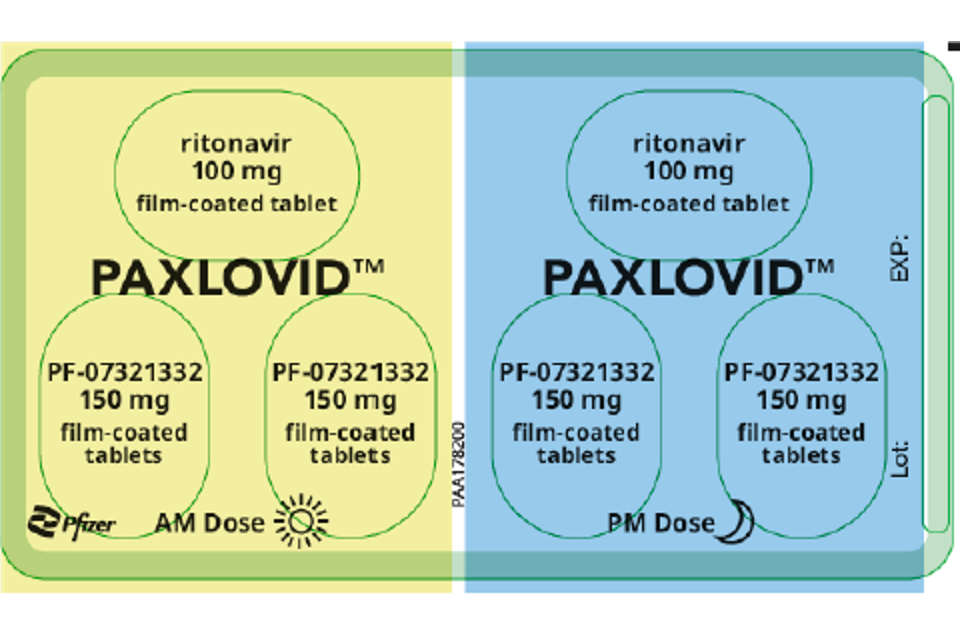Patient information for Paxlovid
Updated 4 May 2022
Paxlovid is an antiviral medicine that stops SARS-CoV-2 (the virus that causes COVID-19) from multiplying in the body. This keeps virus levels in the body low and helps the immune system to overcome the viral infection.
Paxlovid contains 2 different active ingredients: PF-07321332 (nirmatrelvir) and ritonavir. The PF-07321332 (nirmatrelvir) and the ritonavir come in separate tablets that are packaged together.
Each dose consists of 2 tablets of PF-07321332 (nirmatrelvir) and 1 tablet of ritonavir, which are taken together twice a day, for a total of 5 days. Please make sure that you complete a 5-day course of this medicine, even if your symptoms improve and/or you feel better, to reduce the chances of a treatment-resistant version of the virus developing.
Take exactly as prescribed, do not save for later or share with others.
Please make sure that you have informed your doctor or a healthcare professional if you suffer from kidney or liver disease.

Figure 1: Demonstration of Paxlovid packaging and dosage required to be taken. You need to take all 3 tablets behind the yellow foil in the morning and all 3 tablets behind the blue foil in the evening. Please make sure that you take the medication as instructed by your doctor or a healthcare professional.
You should talk to your doctor or a healthcare professional if you do not feel better or if you feel worse while on treatment with Paxlovid.
As you have tested positive for COVID-19, please make sure that you follow the current government guidance on self-isolation and testing.
Information for people taking other medicines
If you are taking any other medicines including herbal medicines and medicines bought from a pharmacy, shop or online, please read the following carefully before taking Paxlovid.
Taking Paxlovid at the same time as some other medicines can cause serious side effects or stop Paxlovid from working properly. Paxlovid can also stop some other medicines from working properly. It is very important that you read carefully the information leaflet that comes in the box with the Paxlovid tablets, which gives more information about medicines that shouldn’t be taken with Paxlovid.
You have been prescribed Paxlovid after a detailed discussion with your doctor or a healthcare professional about your health, medical conditions and any other medicines you are taking. It is very important that you follow the doctor or healthcare professional’s instructions about how to take Paxlovid and how to take your other medicines while taking Paxlovid.
This includes medicines prescribed by your GP practice or hospital, medicines prescribed privately outside of the NHS, and any medicines bought from a pharmacy, shop or online without a prescription. Remember to also include herbal remedies and vitamin supplements you are taking, as well as medicines that come in patches, inhalers, suppositories, pessaries, lozenges, gels, ointments or creams.
If you think you might have forgotten to tell your doctor or a healthcare professional about one or more of the medicines you are taking or if you have any questions, please contact the number or the relevant healthcare professional that they have advised you to contact.
Tell your doctor, pharmacist or any other healthcare professional that you are taking Paxlovid before:
- starting a new medicine
- stopping a medicine you are already taking
- changing the dose of a medicine you are already taking
Information on Paxlovid and pregnancy
If you are pregnant or a person of childbearing potential, please read the following carefully.
There are currently no data on the use of Paxlovid in pregnancy and so it is not recommended during pregnancy.
If you are able to become pregnant you must use effective barrier contraception (for example a condom, female condom, diaphragm or cap) for the duration of treatment and until one full menstrual cycle is completed after the last dose of Paxlovid. Paxlovid can stop combined oral contraceptive pills (‘the pill’) from working properly, so if you use a combined oral contraceptive pill, you must use a barrier method of contraception in addition to the oral contraceptive pill for the duration of treatment with Paxlovid and until one full menstrual cycle is completed after the last dose of Paxlovid.
If you find out that you are pregnant, or became pregnant while taking Paxlovid, or shortly after, please report this by contacting the UK COVID-19 Antivirals in Pregnancy Registry on 0344 892 0909 or by asking your doctor to do this on your behalf. For more information go to the COVID-19 Antivirals Pregnancy Registry.
In addition, please inform your doctor or a healthcare professional as you will need to be followed up closely.
Information for people who are breastfeeding
If you are breastfeeding, please read the following carefully.
It is not known how much Paxlovid passes into breast milk. The manufacturers advise that breastfeeding is not recommended during treatment with Paxlovid and for 7 days after the last dose.
Talk to your doctor or a healthcare professional if you are breastfeeding, further specialist advice is available to them. They can discuss with you your individual situation and the benefits and risks of treatment with Paxlovid while breastfeeding.
Side effects
Like all medicines, Paxlovid can cause side effects. Most of these are mild and short-term, and not everyone gets them.
Reporting side effects
Report any suspected side effects to the Yellow Card scheme using the dedicated Coronavirus Yellow Card reporting site or the Yellow Card app.
- Speak to your healthcare professional for advice if you are worried about your health
- Check the patient information leaflet supplied with the medicine. You can also find this information on the MHRA Coronavirus Yellow Card reporting site
- Report side effects on the MHRA Coronavirus Yellow Care reporting site or use the Yellow Card app
- If unsure or in doubt, report it anyway as only a suspicion of a side effect to the medicine is needed to report.
